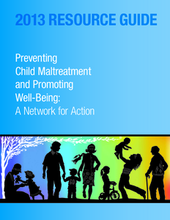This Resource Guide was developed to support service providers in the US in their work with parents, caregivers, and their children to prevent child abuse and neglect and promote child and family well-being. It was created by the U.S. Department of Health and Human Services, Children’s Bureau, Office on Child Abuse and Neglect, its Child Welfare Information Gateway, the FRIENDS National Resource Center for Community-Based Child Abuse Prevention, and the Center for the Study of Social Policy—Strengthening Families. The resources featured represent the work of a broad-based partnership of national organizations, Federal partners, and parents committed to strengthening families and communities.
The Resource Guide was created primarily to support community-based child abuse prevention professionals who work to prevent child maltreatment and promote well-being. However, others such as policymakers, parent educators, family support workers, health-care providers, program administrators, teachers, child care providers, mentors, and clergy also will find the resources useful.
Resources include:
- Chapter 1: Laying the Groundwork—Information about the research and theory on which the Resource Guide is based, including a framework for understanding child well-being, protective factors that help reduce child abuse and neglect, and strategies for creating lasting change in how communities support families.
- Chapter 2: Working With Families: The Six Protective Factors—Detailed information about each of the protective factors and tips for infusing them into programs and direct practice with families and children.
- Chapter 3: Engaging Your Community— Strategies to help build community awareness and support the development of broad-based community partnerships.
- Chapter 4: Protecting Children—Information about why child abuse occurs, risk factors, consequences, identifying and reporting maltreatment, and supporting parents and children with a history of trauma.
- Chapter 5: Tip Sheets for Parents and Caregivers—Strengths-based tip sheets on specific parenting topics that can be used in discussions or visits with caregivers, and calendars of activities to help programs, parents, and community partners celebrate Child Abuse Prevention Month.
- Chapter 6: Resources—Contact information for private and Federal partners working nationally to strengthen families.
The document also includes Spanish-language tools and resources.
©Children's Bureau, Office on Child Abuse and Neglect, its Child Welfare Information Gateway, the FRIENDS National Resource Center for Community-Based Child Abuse Prevention, and the Center for the Study of Social PolicyâStrengthening Families

